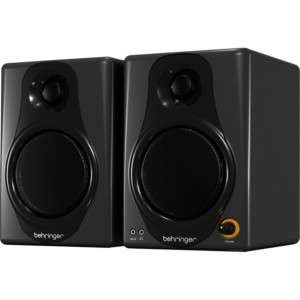
How to choose a used acoustic piano?
Prices for used pianos are usually small (from 0 rubles, often just for pickup), so the quality of such instruments can be of any kind. In order not to mess around with nonsense and immediately assess whether it is worth contacting the tool or not, follow a few rules.
General rules:
1. Pianos of foreign manufacturers are considered to be much better quality instruments, especially old ones – from the 60s-70s of the XX century (but not 80-90s), and what is very important – native, not Chinese, assembly. Regrettably, a rare specialist recommends supporting a Russian manufacturer.
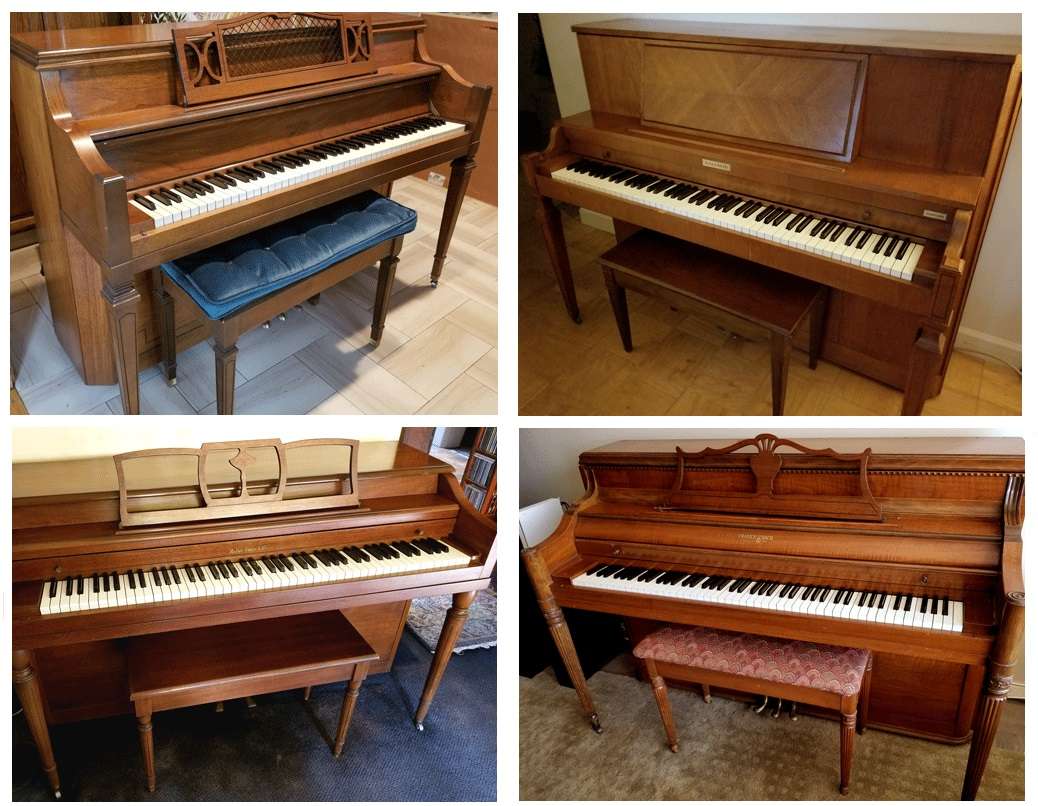
Foreign pianos of the 60-70s
2. The price of a used piano should be significantly less than a new one, even if it’s a great company and hasn’t been played at all. Working with a private trader, you will not receive either quality delivery or a guarantee for the tool. And at least you win the price.
Body, deck, frame:
1. The body is the very first indicator. If it doesn’t satisfy you, just move on to the next piano and don’t bother looking at everything else. The case should be free of cracks (cracks make the sound rattling). If the veneer peels off, it means that the piano was stored incorrectly: first in a damp room, and then in a too dry one. Such storage inevitably affected the “insides” of the instrument.
2. Deca .
______________________
The soundboard is the back wall of the piano that transmits vibrations from the strings to the air,
making the sound much louder than the string itself produces.
________________
The soundboard has everything to do with sound, so inspect it carefully. If it has a couple of small cracks, it’s not scary (see photo on the left). For example, in St. Petersburg you will hardly find a used piano with a whole soundboard (this is due to climatic conditions), which does not affect the quality of education of local talents.

On the left is a deck with small cracks, on the right with large and numerous
But if there are a lot of cracks in the deck, you should not take the tool (see photo on the right). Who knows what broke the deck so badly and what else these manipulations affected.
3. Cast iron frame (not to be confused with deck). It is really cast iron, because. created in order to withstand the tension of the strings, and this is about 16 tons. That is why there should not be any cracks in it. Look carefully: cracks can be small, but not every restoration center will undertake to eliminate them (for lack of the necessary equipment), and repairs of this kind are considered major.
Keys:
1. Be sure to press each key and listen to how it sounds – if it sounds at all! Also, make sure that the keys do not sink down, do not knock on the bottom of the keyboard and fall to the same height.
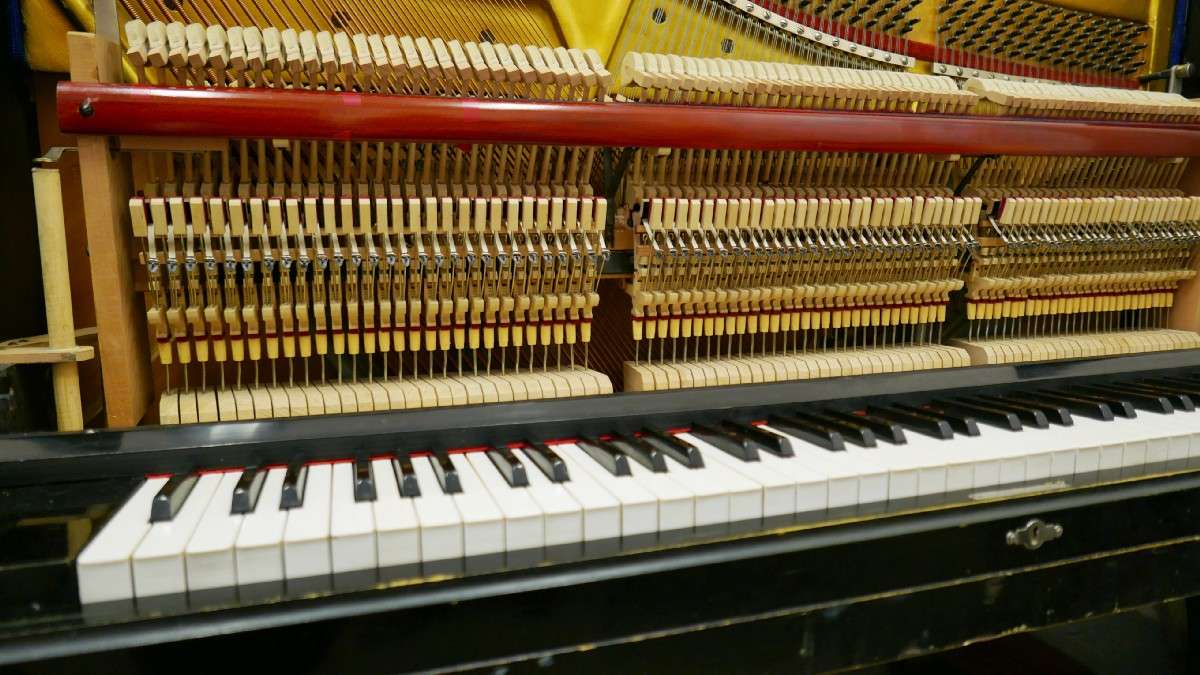
Keyboard
2. Look at the keys from the side: you need them all to be in the same plane.
3. If the keyboard is too tight, it is not suitable for a child; conversely, a keyboard that is too light means that the mechanism is worn out.
4. Moth can eat important parts of the piano – drukshayba under the keys.
______________________
A drukshayba is a round washer located on the front pin of the keyboard.
Made from cloth and paper.
________________
Damaged drukshayba often go unnoticed even by experienced tuners. In order not to bring a breeding ground of moths into your house, so as not to replace all the drukshay and reinstall the keyboard (and this is not cheap), check everything at once. To do this, remove the top panel, cirleist (fabric over the keys) and remove the keyboard clap. There should be whole drukshaybs under it. Protect your instrument by placing 2-3 moth washers in the housing.
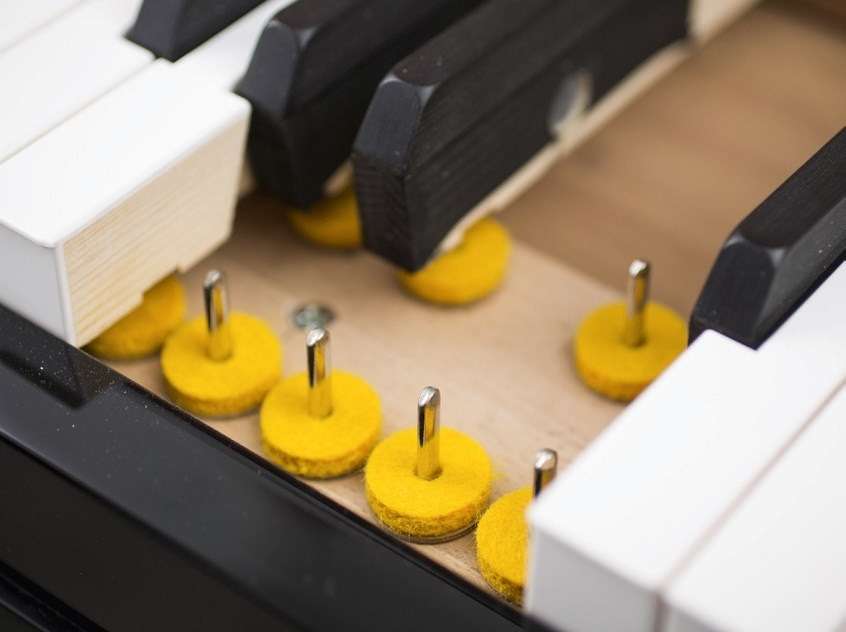
Whole drukshayba
Hammers:
1. Remove the top and bottom covers and inspect the insides. Here you can evaluate the condition of the hammers. There should be 88 of them, as well as keys. If more than 12 of them stagger, then the mechanism is very worn out.
2. Felt on the hammers: if it has grooves from the strings or the felt itself is heavily worn, then the piano has been actively used. It is not good!
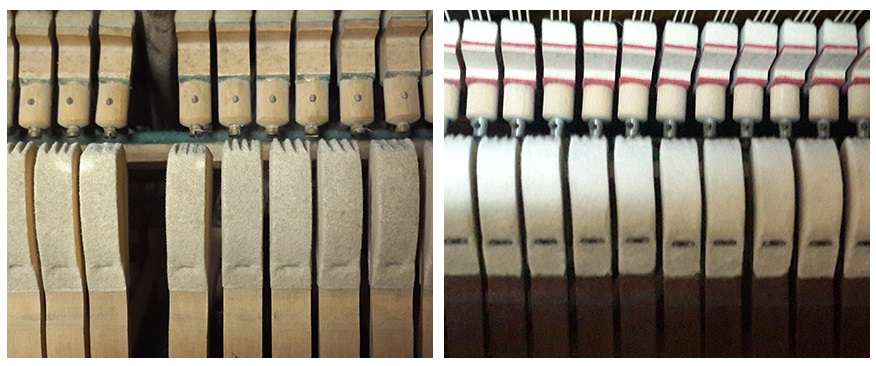
In the photo on the left, the hammers are no good, on the right, a small working is visible, but this is a good condition
3. What does the hammer do when you press the key: it should bounce immediately after you release the key and should not hit other hammers. If it hurts, this is another sign that the piano has worked out its own.
Strings:
1. Inspect the strings. Notice the large distance between adjacent strings, which means that one string is missing. Also, in the choir (a set of several strings), one or even several strings may be missing – this is noticeable by itself, as well as by the fact that other strings will be stretched obliquely.
2. If the strings are attached to the pegs in an unusual way, there were breaks in the strings. This is bad. When an instrument lacks 2-3 strings or it can be seen that there were several breaks, such an instrument cannot be bought. Everything else can fly within a year.
3. There are few rusty strings – it’s not scary. These specific instances can be checked for sound quality: satisfied – excellent. There are a lot of rusty strings – it is better not to take an instrument. He probably won’t last long.
Kolki and virbelbank:
______________________
Pegs (virbels) are small metal pins with which the strings are stretched. When tuning the piano, the master twists them, achieving the desired tension. They are driven into a wooden base called a wirbelbank. The virbelbank and the pegs themselves can wear out .
________________
1. When examining this part of the instrument, pay attention to whether the pegs are firmly seated in the wirbel bank, whether they stagger, whether there are additional parts between the peg and the tree. If any of this is, then run away from this tool, it cannot be restored.
2. How the pegs are driven in. More advanced specialists look at how tightly the pegs are driven into the tree.
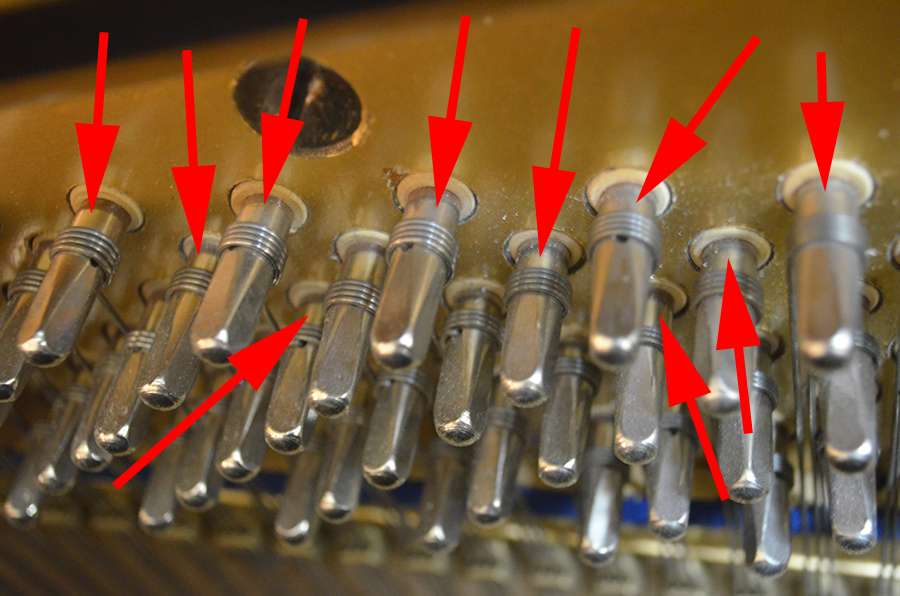 Good stock on pegs
Good stock on pegs
Pegs are driven in when the system weakens. A loose tuning is when the pin does not hold its position after tuning due to the pressure of the stretched string and scrolls back. In the tool, 3-5 mm are specially designed for this, on which pegs can be driven in so that they sit stronger in the tree. If you see that these 3-5 mm are not between the wound string and the tree, know that the instrument was losing tuning.
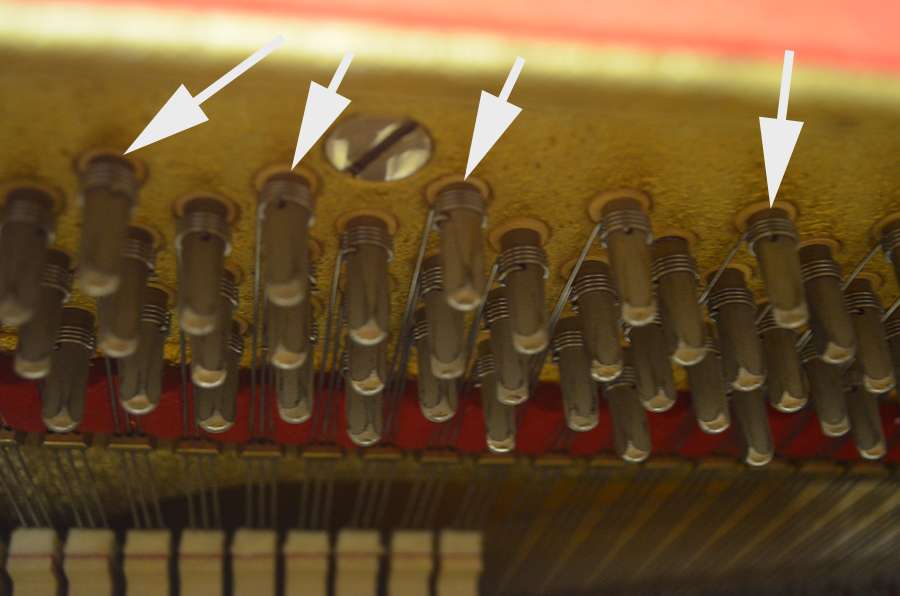
Knocked out pegs
Some masters recommend not to mess with such a piano. Others argue that there is nothing wrong here, and if the tool is of respectable age and a good foreign company, it will last a long time. But unequivocally, hammered pegs are an occasion to think and ask questions.
Pedals:
1. Must walk smoothly, not jam, perform their functions. The right pedal amplifies and prolongs the sound of the keys, making the sound deeper (this is done by lifting the dampers).
______________________
A damper is a soft cushion designed to dampen the strings after the corresponding key has returned to its original position. The damper mechanism allows you to avoid unwanted rumble when playing.
________________
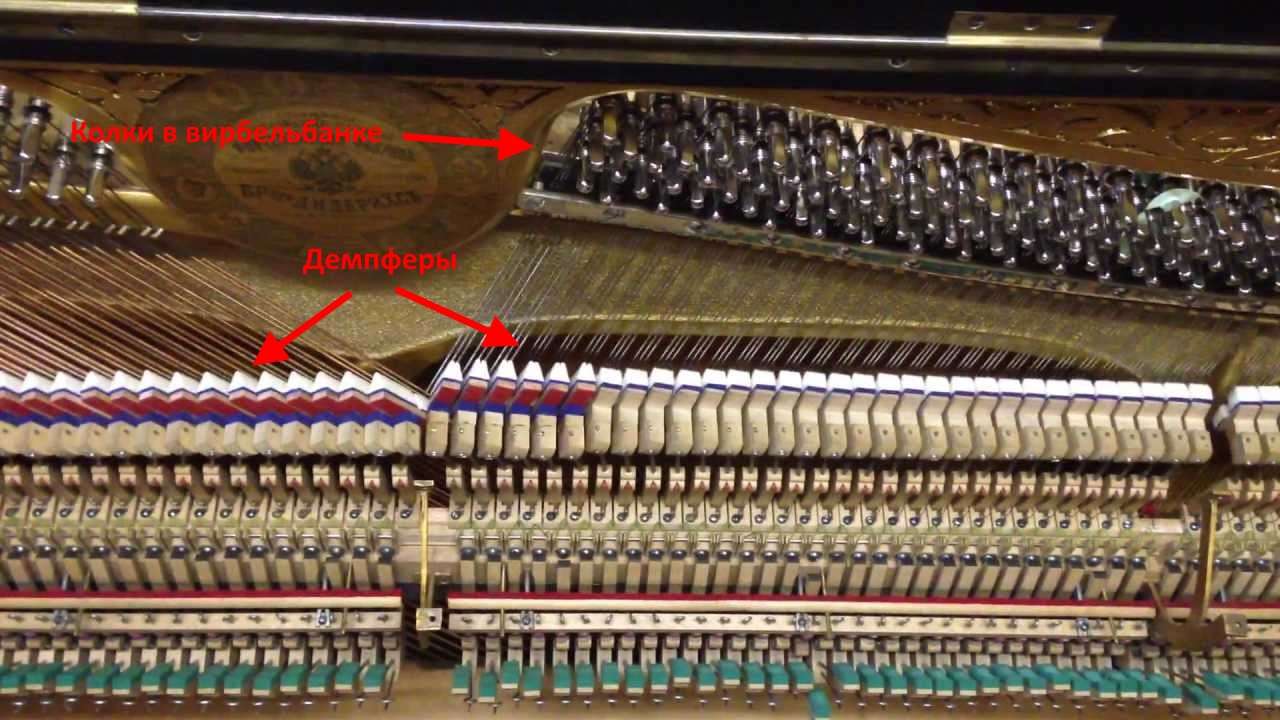
dampers
The left pedal muffles the sound due to the displacement of the hammers. The middle one prolongs the sound of the key that is pressed simultaneously with this pedal. If the pedals are shiny, then the piano has been played.
Story:
1. Where it stood. The piano is a wooden instrument: if it stood next to a window or a radiator, it most likely dried out. But even worse if it was in an unheated room, for example, in the country. This should not be taken at all, it is definitely spoiled due to changes in humidity.
2. Who and how much played. When they play for several hours a day, the mechanism becomes very loose. This happens if the piano is in a music school or serves a professional musician. It is better to refuse such a tool. There is another extreme: the piano stood idle for several years, it was not played, it was not tuned – it could lose its tune.
3. How many times they drove. Be sure to find out how many owners were before you and how many times the piano was transported. Each transportation can have a negative impact, one strong blow is enough – and the piano will be “out of tune” forever.

Be sure to find out how many owners were before you and how many times the piano was transported
A long list of rules and tips demonstrates how difficult it is to choose a used piano. Professionals will greatly facilitate the task: a tuner or a restoration company.
I’ll warn you right away that the tuner may turn out to be a person of interest: he “recommended” a piano that would require expensive repairs, and then he carried it out himself! If you do not trust the tuner, try this: contact a company that has been selling used pianos for a long time. Offer her the piano that you have chosen: if it interests her, take it too. These guys, through their experience of restoration and resale, made sure which manufacturers are worth dealing with, and which ones are better not to mess with.
Be sure to listen to how the instrument sounds: a soft and deep sound is more preferable than a rattling and sonorous one. In any case, it should be pleasant for you, because. will either delight or torment your ears for many years of playing music together.
This video will help you figure out how the “correct” piano should sound:





